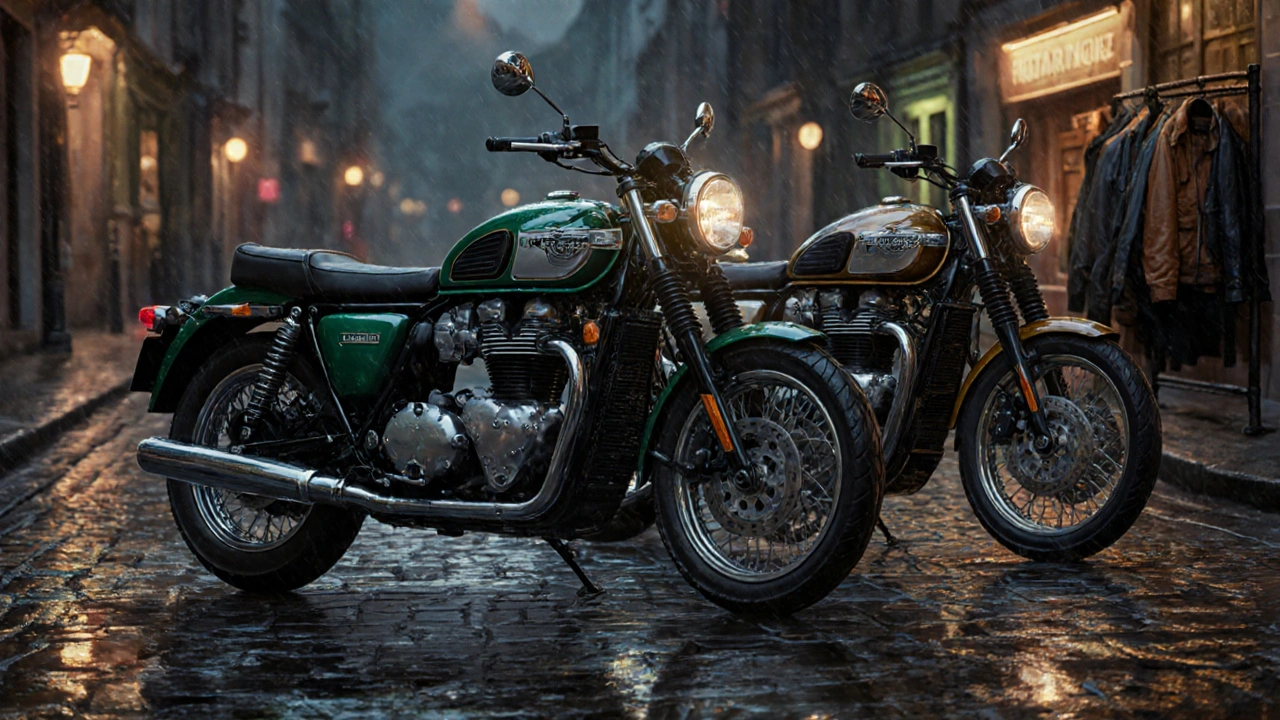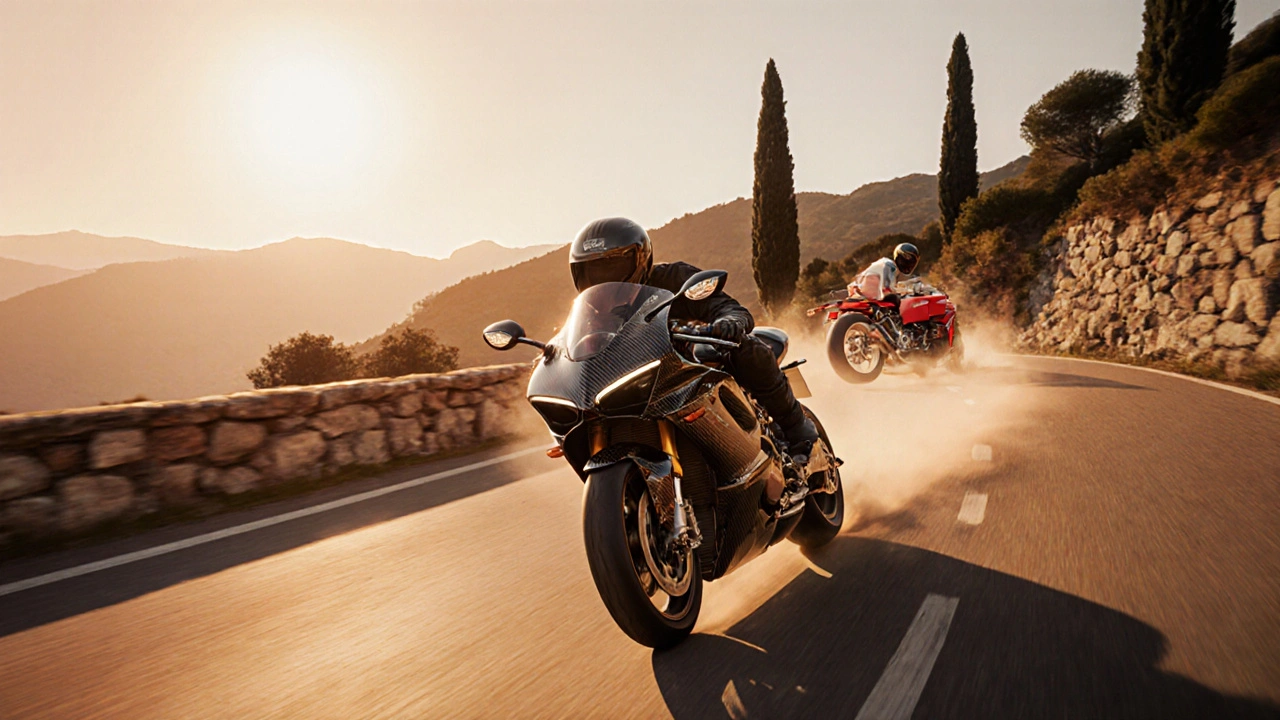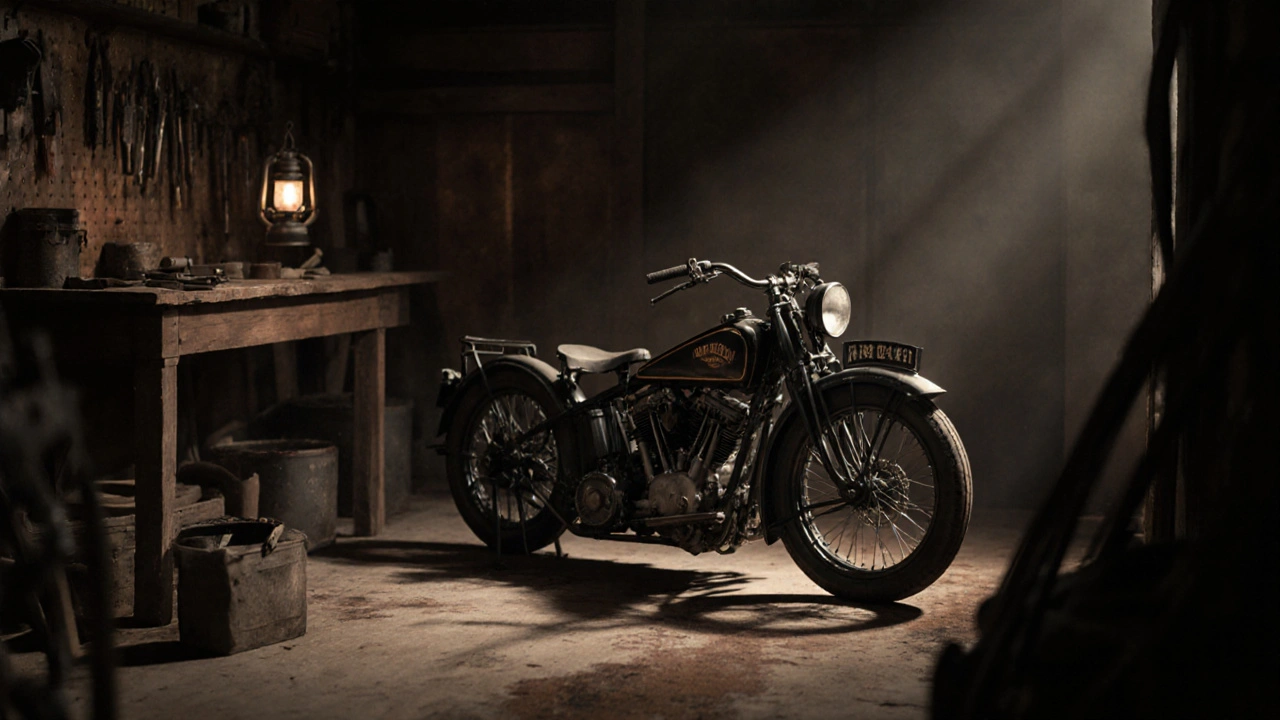When you hear the name Harley-Davidson, Triumph, or Ducati, you don’t just think of a bike-you think of a story.
These aren’t just machines. They’re steel-and-leather time capsules that rolled out of workshops in the early 1900s and kept rolling through wars, economic crashes, and cultural revolutions. Today, they’re still on the road, but they’ve changed. Not just in looks, but in how they’re made, who rides them, and why they still matter.
Harley-Davidson: American Grit Turned Global Icon
Harley-Davidson didn’t start as a luxury brand. In 1903, William Harley and the Davidson brothers built their first bike in a 10x15-foot shed in Milwaukee. It had a 40cc engine, no suspension, and a single gear. By 1920, they were making over 30,000 bikes a year-more than any other manufacturer in the world.
During World War II, Harley built over 90,000 military bikes for the U.S. Army. The WLA model became legendary for its reliability in mud, sand, and snow. After the war, returning soldiers brought those bikes home. That’s when the outlaw image took root-not because Harley promoted it, but because riders like Marlon Brando in The Wild One made it stick.
Fast forward to 2025, and Harley’s still the biggest name in American motorcycles. But today’s Sportster and Street Glide aren’t just clones of 1950s models. They’re packed with ride-by-wire throttles, traction control, and connected dashboards. The LiveWire electric bike, launched in 2021, proved Harley could innovate without losing its soul. Sales dipped in the late 2010s, but younger riders are coming back-not for the chrome, but for the brand’s DNA: raw power, custom culture, and a community that feels like family.
Triumph: From British Workhorse to Modern Classic
Triumph’s story is the opposite of Harley’s. It didn’t grow through rebellion-it grew through precision. Founded in 1902 in Coventry, England, Triumph made reliable, mass-produced machines for the middle class. By the 1950s, their Bonneville was the fastest production bike in the world, hitting 120 mph. It became the bike of choice for British riders, Hollywood stars, and even the Royal Mail.
But by the 1980s, Japanese manufacturers like Honda and Yamaha crushed them with cheaper, more reliable bikes. Triumph shut down in 1983. Then came John Bloor, a British property developer who bought the name and rebuilt the company from scratch. He didn’t just revive the brand-he reinvented it.
Today’s Triumph Bonneville is a masterpiece of modern heritage. It looks like the 1960s original, but under the tank is a 1200cc liquid-cooled parallel-twin engine, ABS, and ride modes. The company now sells over 100,000 bikes a year globally. Their Street Twin, Thruxton, and Scrambler lines all carry that classic silhouette-but with fuel injection, LED lights, and smartphone connectivity. Triumph didn’t just survive. They turned nostalgia into a business model that works for 20-year-olds and 60-year-olds alike.

Ducati: Racing Bloodline in Every Frame
If Harley is the cowboy and Triumph is the gentleman, Ducati is the race car driver who never took off their helmet. Founded in 1926 in Bologna, Italy, Ducati started by making radio parts. They switched to motorcycles in the 1950s after their patented Desmodromic valve system-where valves are opened and closed by cams instead of springs-proved it could handle insane engine speeds.
By the 1970s, Ducati was winning World Championships with bikes like the 750 SS. Their L-twin engines, with that signature growl, became the sound of speed. Even in the 1990s, when most brands were moving to four-cylinder engines, Ducati stuck with twins-and made them better.
Today, Ducati’s lineup includes everything from the affordable Monster to the insane Panigale V4 R, which costs more than a luxury sedan. But their real magic is in the middle: the Scrambler, the Diavel, and the Multistrada. These bikes look like they came from a 1970s garage, but they’re built with carbon fiber, cornering ABS, and semi-active suspension. Ducati riders don’t buy a bike to cruise-they buy it to feel alive. And that’s why Ducati still sells out every model they make.
Indian Motorcycle: America’s Forgotten Giant
Most people don’t know Indian was the first American motorcycle brand-and for a while, the biggest. Founded in 1901 in Springfield, Massachusetts, Indian beat Harley to market by two years. By 1913, they were making 32,000 bikes a year. Their Scout and Chief models were the Cadillac of motorcycles: smooth, powerful, and packed with features.
But after World War II, Indian’s management failed to adapt. They kept building heavy, outdated bikes while Harley modernized. By 1953, Indian was out of business.
Then, in 2011, Polaris Industries bought the name and brought Indian back. The new Chief and Scout weren’t just copies-they were reimagined. The 2025 Scout Bobber, for example, has a 1,133cc liquid-cooled V-twin, a 5-inch touchscreen, and a weight under 500 pounds. Indian’s new electric model, the FTR EV, is set to launch in early 2026. What’s remarkable? Indian didn’t try to be Harley. They carved out their own space: American-made, premium, and understated. Today, they’re the fastest-growing motorcycle brand in the U.S.
Why Heritage Brands Are Winning in 2025
Here’s the surprise: younger riders are choosing these old names over new ones. Why? Because they’re not buying a product-they’re buying identity.
A 2024 study by the Motorcycle Industry Council found that 68% of riders under 35 who bought a heritage motorcycle said they chose it for its “authentic history.” That’s higher than those who picked Japanese or European brands for performance alone.
These brands have mastered something modern companies struggle with: emotional continuity. They didn’t just update their bikes-they updated their stories. A 2025 Triumph owner isn’t riding a 1968 Bonneville. They’re riding a 2025 Bonneville that remembers what made the original special.
And it’s not just about looks. Heritage brands invest in craftsmanship. Their engines are hand-assembled. Their frames are welded by people who’ve done it for 30 years. Their paint jobs take 12 hours to cure. You can’t mass-produce that kind of soul.

The Dark Side of Nostalgia
But it’s not all smooth rides. Some heritage brands have stumbled trying to stay relevant.
BSA, once a British giant, tried a comeback in 2020 with a retro-styled electric bike. It looked great, but the battery lasted 60 miles and cost $15,000. It sold fewer than 500 units. The lesson? You can’t slap a vintage badge on a half-baked product.
And then there’s the price. A new Harley-Davidson Street Glide starts at $24,999. A Triumph Bonneville T120 is $12,999. That’s more than most new sedans. For many, that’s a hard sell.
That’s why used markets are booming. In 2025, the average price of a 1980s Harley on Craigslist in the U.S. rose 27% year-over-year. The same is true for 1970s Triumphs in the UK. People who can’t afford the new ones are buying the old ones-and restoring them themselves.
What’s Next? Electric, Custom, and Community
The future of heritage brands isn’t about going back. It’s about going forward-on their own terms.
Electric is the biggest shift. Harley’s LiveWire, Triumph’s Tiger Electric prototype, and Indian’s FTR EV are all real. They’re not gimmicks. They’re the next chapter.
Customization is another key. Brands now offer more factory options than ever: color combos, seat styles, exhausts, even custom paint jobs you can design online. You’re not just buying a bike-you’re co-creating it.
And then there’s community. Heritage brands don’t just sell bikes. They sell belonging. Ride-outs, owner clubs, restoration workshops-these aren’t marketing tactics. They’re the reason people stay loyal. A 2025 Harley owner doesn’t just ride. They show up at the annual Sturgis rally. A Triumph rider joins a Bonneville owners’ group in Bristol. These aren’t hobbies. They’re identities.
Final Thought: The Bike That Outlived Its Time
These brands didn’t survive because they were perfect. They survived because they were human. They made mistakes. They got lost. They nearly died. But they listened. They adapted. They kept the heart.
When you ride a modern heritage bike, you’re not just riding a machine. You’re riding 120 years of sweat, innovation, rebellion, and pride. And that’s something no app or algorithm can replicate.
Are heritage motorcycle brands worth the higher price?
Yes-if you value craftsmanship, history, and emotional connection over raw specs. Heritage bikes cost more because they’re hand-built, use premium materials, and come with decades of brand legacy. You’re paying for a story, not just a bike. For riders who care about design, culture, and long-term value, the price makes sense. For those who just want to commute, a new Japanese bike might be smarter.
Can you still get parts for vintage heritage bikes?
Absolutely. Brands like Harley-Davidson, Triumph, and Indian still produce OEM parts for models dating back to the 1970s. Independent suppliers like NOS (New Old Stock) vendors and specialty shops keep vintage parts alive. Online forums and restoration groups also share schematics and custom-made replacements. If a part doesn’t exist, someone will make it.
Do heritage brands make good first bikes?
Not usually. Most heritage models are heavy, powerful, and designed for experienced riders. A 1970s Triumph Bonneville weighs over 500 pounds and has a high seat. Modern versions are better, but still not ideal for beginners. New riders should start with lightweight, low-seat bikes like the Honda CB300R or Yamaha MT-03. Once they gain confidence, they can move to a heritage model.
Are electric heritage bikes the future?
They’re part of it. Harley’s LiveWire and Indian’s FTR EV prove that heritage brands can go electric without losing their identity. The key is preserving the character-the sound, the stance, the feel. Electric motors deliver instant torque, which suits these bikes perfectly. But buyers still want the look and soul of the original. The future will be hybrid: electric power with classic design.
Why are used heritage bikes getting more expensive?
Because demand is outpacing supply. As new models get pricier, riders are turning to vintage bikes as an affordable way to own heritage. At the same time, collectors and restorers are snapping up clean examples. Bikes from the 1960s-1980s in good condition are now considered classic assets. A well-maintained 1972 Triumph Bonneville can sell for $15,000-$25,000 today-up from $5,000 a decade ago.


Comments
Krzysztof Lasocki
I rode a 1978 Harley on a cross-country trip last year. Didn't have cruise control, didn't need it. Just me, the rumble, and the open road. Modern bikes got all the buttons, but they forgot how to make you feel something. This post? Spot on.
November 4, 2025 at 08:34
Henry Kelley
used a 89 triumph for my first bike. broke down 3 times in 2 weeks. still love it. the smell of the oil, the way the clutch felt... no app can replicate that. even if it costs 12k now.
November 4, 2025 at 19:19
Victoria Kingsbury
The emotional continuity argument is legit. These brands aren't just selling motorcycles-they're selling ancestral memory. The Desmodromic valve system? That's not engineering, that's poetry in motion. And the hand-welded frames? That's craft as cultural preservation. Modern EVs might be efficient, but they lack the soul of a 1972 Bonneville’s exhaust note. You can't algorithmically generate patina.
November 5, 2025 at 04:43
Tonya Trottman
Let’s be real. ‘Soul’ is just marketing jargon for ‘expensive and over-engineered.’ You pay $15k for a bike that needs a $2k tune-up every 20k miles. Meanwhile, my 2023 Honda CB500X gets 60mpg, starts in -10°F, and doesn’t require a PhD to fix. But sure, let’s romanticize the maintenance nightmare.
November 5, 2025 at 16:57
Rocky Wyatt
You people are delusional. You think you’re riding history? Nah. You’re riding a status symbol your dad bought you for graduation. Real riders don’t care about badges. They care about miles. And if you’re not out there at 3am on a backroad with no lights, you’re not a rider-you’re a decorator.
November 5, 2025 at 22:19
Santhosh Santhosh
I grew up in a small town in India where the only motorcycle was a 1980s Hero Honda. But I read every article I could find about Triumph and Ducati. The stories they tell-about rebellion, craftsmanship, silence between gears-they felt like the only truth in a world full of noise. I saved for five years to buy a used 2004 Triumph Tiger. It doesn't start on the first try, but when it does, it feels like the world holds its breath. That's the magic. Not the specs. Not the price. Just... that moment.
November 7, 2025 at 13:45
OONAGH Ffrench
The electric shift is inevitable but the soul must remain. The sound of a Ducati L-twin is not just noise-it is the heartbeat of Italian engineering. An electric motor can mimic torque but not the vibration that travels up your spine. Heritage is not about nostalgia. It is about continuity of intention.
November 7, 2025 at 20:40
Shivam Mogha
Used bikes are the real deal.
November 8, 2025 at 17:58
mani kandan
I restored a 1975 Honda CB750 last year. Found the original owner’s name etched inside the fuel tank. He was a Vietnam vet. His son reached out after seeing my posts. We met at a diner. He gave me his dad’s gloves. Said, ‘He’d want you to ride it.’ That’s not a motorcycle. That’s a time machine. No app can do that. No algorithm. Just hands. And heart.
November 9, 2025 at 12:00
Rahul Borole
The resurgence of heritage motorcycle brands represents a paradigmatic shift in consumer behavior from transactional utility to ontological identity formation. The premium pricing structure is not merely a reflection of production cost differentials but rather a socio-cultural valuation of embodied heritage, artisanal labor, and symbolic capital. Furthermore, the integration of electrification protocols into classical chassis architectures constitutes a dialectical synthesis of tradition and innovation, wherein the phenomenological experience of riding is preserved through technological augmentation. This evolution underscores the resilience of cultural institutions when anchored in narrative coherence and collective memory.
November 11, 2025 at 07:34
Krzysztof Lasocki
Rahul, you just wrote a thesis. I just wanted to know if you’ve ever had to replace a carburetor at 2am in the rain. Spoiler: you didn’t. I did. And I still love every second of it.
November 12, 2025 at 16:12